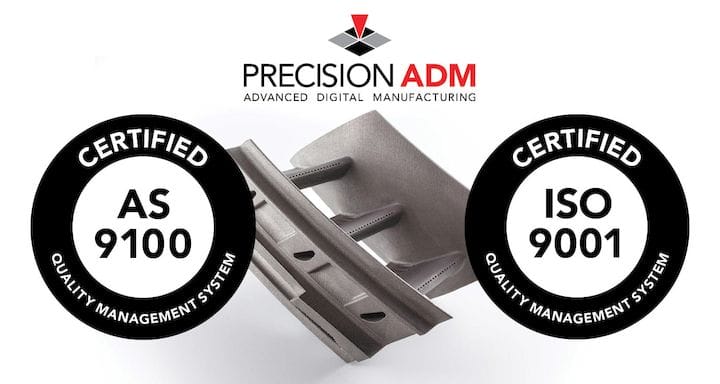![Precision ADM announces more industry certifications [Source: Precision ADM]](https://fabbaloo.com/wp-content/uploads/2020/05/image-asset_img_5eb0a0298f853.jpg)
Right on the heels of Sculpteo’s announcement regarding ISO 9001 certification, we see that Precision ADM has announced something quite similar.
The Canadian 3D print service specializing in metal printing for the aerospace and medical industries announced they’ve achieved AS9100 Rev D and ISO 9001-2015 Quality Management System Certifications.
They say:
“Implementing this standard enables Precision ADM to manufacture aerospace and aerospace related parts using the latest digital manufacturing technologies. Utilizing technologies like metal additive and subtractive processes, Precision ADM can lower production costs by reducing waste and decreasing time to market.
Additive manufacturing also makes it possible to simplify and combine parts with complex geometries, with the potential to lower operation costs. Precision ADM is currently targeting additively manufactured aerospace parts in materials such as Titanium, Cobalt-Chrome, Inconels, and other critical aerospace alloys.”
Precision ADM’s CEO, Martin Petrak, explained further:
“Our team continues to prove to be industry leaders. In 2017 we were the first Canadian metal AM service provider to achieve ISO 13485 certification for medical applications, and now in 2018 we are again the first to hold both certifications for medical and aerospace.”
It’s a significant achievement for Precision ADM, but it also provides a vote towards our theory outlined in our post about Sculpteo’s similar achievement: that 3D print services should now focus on industry certifications to differentiate themselves from the competition.
Just because you have a 3D printer does not mean you can definitively operate it consistently and reliably, time after time. Today anyone can buy a 3D printer if sufficiently funded, but to get the most out of the device one must have significant operational experience, and that’s hard to come by unless you’ve actually been doing 3D printing for some time. Capturing all those lessons into a defined procedure is what produces consistency, and the ISO certifications are what declares these procedures appropriate to the rest of the industry.
In today’s world 3D printing is gradually moving into the world of manufacturing production, where the need for consistency and reliability is far greater than 3D printing’s traditional niche of prototyping. This is even more true for metal 3D printing, where parts made are increasingly used in critical functions, sometimes involving life and death.
The clear message here is that any professional 3D print service had better obtain as many certifications as is reasonable in order to maintain a proper presence in the market.
At some point we will find virtually all 3D print services to have a number of certifications and thus being able to consistently produce parts of high quality.
If that were the case, why would anyone consider using an uncertified 3D print service?
Via PRWeb and Precision ADM











MakerOS has a brilliant hidden feature in their online service: a sophisticated 3D print pricing calculator that allows operators to determine exactly how to price prints.